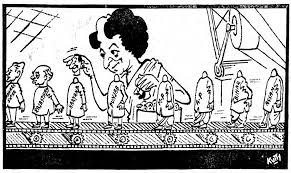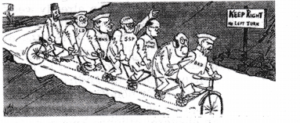#Fight with Covid_19
Fourth General Elections, 1967
- The year 1967 is considered as a landmark year in India’s political and electoral history.
- In prevailing political environment the economic situation trigerred off price rise. People started protesting against the increase in prices of essential commodities, food scarcity etc.
- The communist and socialist parties launched struggles for great equality.
- 1960s also witnessed some of the worst Hindu-Muslim riots since Independence.
Non-Congressism
- Opposition parties were in the forefront of organising public protests and pressurising the government.
- These opposition parties felt that the inexperience of Indira Gandhi and the internal fractionalism within the Congress provided them an opportunity to topple the Congress.
- The socialist leader Ram Manohar Lohia gave this strategy the name of Tion-congressism’.
Electoral Verdict
- The fourth general elections to the Lok Sabha and State Assemblies were held in February 1967.
- The results jolted the Congress at both the national and state levels, and it was termed as ‘political earthquake’.
Coalitions
- The elections of 1967 brought into picture the phenomenon of coalitions.
- Since no single party had got majority, various non-congress parties came together to form joint legislative parties (called Samyukt Vidhayak Dal in Hindi) that supported non-congress governments.
Defection
Defection means an elected representative leaves the party on whose symbol he/she elected and joins another party. The constant realignments and shifting political loyalties in this period gave rise to the expression ‘Aya Ram, Gaya Ram’.

residential Election, 1969
- The factional rivalry between the Syndicate and Indira Gandhi was clearly visibe when the post of President of India was vacated in 1969 after the death of Zakir Hussain.
- Syndicate supported official candidate of the Congress N.Sanjeeva Reddy while Indira Gandhi supported W Giri as the candidate for the President of India.
- Indira Gandhi announced the nationalisation of fourteen leading private banks and the abolition of the ‘privy purse’ which removed differences between Morarji Desai and Indira Gandhi.
- The defeat of official Congress candidate formalised the split in the party.
The 1971 Election and Restoration of Congress
The Indira Gandhi’s Government recommended the dissolution of the Lok Sabha in December 1970 and the fifth general elections to the Lok Sabha were held in February 1971.
The Contest
- In 1971 election, all the major non-communist, non-congress opposition parties formed an electoral alliance known as the Grand Alliance.
- Indira Gandhi said that the opposition alliance had only one cohunon programme Indira Hatao, in contrast she put forward a positive programme captured in the famous slogan Garibi Hatao.
- This Slogan and the programmes that followed it were part of Indira Gandhi’s political strategy of building an independent nationwide political support base.

1. Prime Minister Pt. Jawaharlal Nehru passed away in May 1964. The 1960s were labelled as ‘dangerous decade’ due to some unresolved problems like poverty, inequality, communal and regional divisions to be speculated to lead to a failure of democratic project or even the disintegration of the country.
2. India mainly faced two challenges from 1964 to 1966 during Lai Bahadur Shastri’s reign like ‘Economic Crisis’ due to Indo-China War of 1962 and Indo-Pak War of 1965 and failed Monsoons, droughts and food crisis which was symbolised as a famous slogan to resolve the issues like ‘Jai Jawan Jai Kisan’.
3. The Congress Party faced the challenge of political succession for the second time after the death of Lai Bahadur Shastri with an intense competition between Morarji Desai and Indira Gandhi to resolved through a secret ballot among Congress MPs. Indira Gandhi defeated Morarji Desai and a peaceful transition of power was seen as a ‘Sign of Maturity of India’s Democracy’.
4. The government of Indira Gandhi decided to devalue the Indian rupee in order to check economic crisis of 1967. Consequently, one US dollar could be purchased for less than Rs 5 after devaluation which cost more than Rs 7 to trigger a price rise and people protested against essential commodities price rise and unemployment. It was struggled even by socialist and communist parties for greater equality.
5. The Congress Party’s decision of devaluation gave birth to the concept of Non-Congressism with different programmes and ideologies to form anti-Congress fronts. It was claimed to be necessary for democratic purposes.